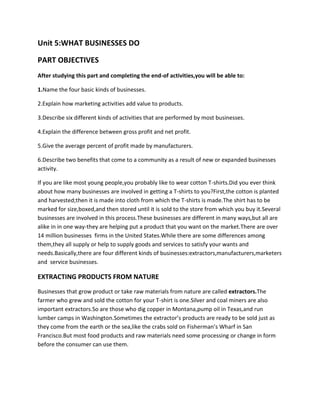
Unit 5
- 1. Unit 5:WHAT BUSINESSES DO PART OBJECTIVES After studying this part and completing the end-of activities,you will be able to: 1.Name the four basic kinds of businesses. 2.Explain how marketing activities add value to products. 3.Describe six different kinds of activities that are performed by most businesses. 4.Explain the difference between gross profit and net profit. 5.Give the average percent of profit made by manufacturers. 6.Describe two benefits that come to a community as a result of new or expanded businesses activity. If you are like most young people,you probably like to wear cotton T-shirts.Did you ever think about how many businesses are involved in getting a T-shirts to you?First,the cotton is planted and harvested;then it is made into cloth from which the T-shirts is made.The shirt has to be marked for size,boxed,and then stored until it is sold to the store from which you buy it.Several businesses are involved in this process.These businesses are different in many ways,but all are alike in in one way-they are helping put a product that you want on the market.There are over 14 million businesses firms in the United States.While there are some differences among them,they all supply or help to supply goods and services to satisfy your wants and needs.Basically,there are four different kinds of businesses:extractors,manufacturers,marketers and service businesses. EXTRACTING PRODUCTS FROM NATURE Businesses that grow product or take raw materials from nature are called extractors.The farmer who grew and sold the cotton for your T-shirt is one.Silver and coal miners are also important extractors.So are those who dig copper in Montana,pump oil in Texas,and run lumber camps in Washington.Sometimes the extractor’s products are ready to be sold just as they come from the earth or the sea,like the crabs sold on Fisherman’s Wharf in San Francisco.But most food products and raw materials need some processing or change in form before the consumer can use them.
- 2. MANUFACTURING NEW PRODUCT The manufacturer takes the extracto’s products or raw materials and changes them into a from that consumers can use.The manufacturer might make a product,such as a toaster,or process a product,such as packaging and freeing vegetables.Some manufacturers are only a part of the totsl activity of producing goods from the extractor’s products.Your T-shirt is an example.The process migth be something like this: A textile mill in North Calorina takes cotton grown on an Alabama farm,spinsit into yarn,and makes the yarn into cloth.Another plant in New England takes the cloth and dyes or prints it. A clothing factory in New York buys the cloth and makes it into shirts.Together,extractors and manufacturers change the form of resourses from their natural ststes into products for consumers.
